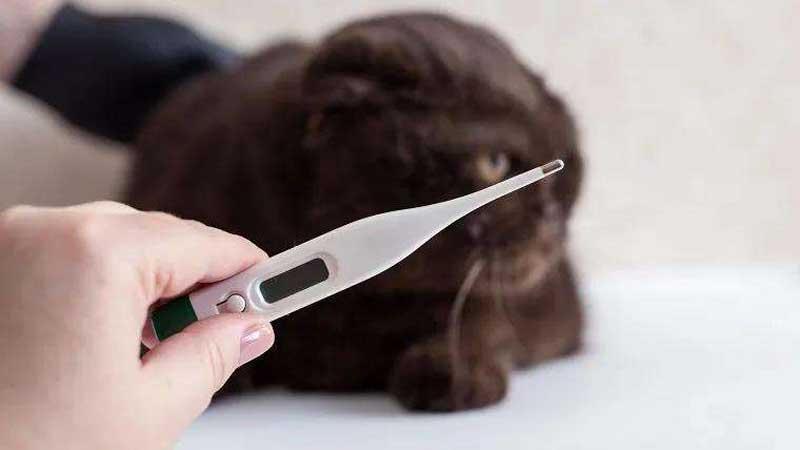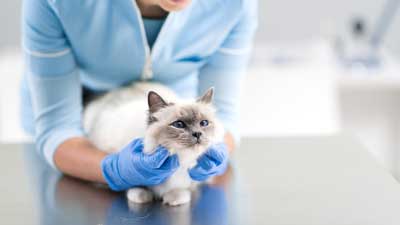What Is The Normal Body Temperature Of A Cat?

Best Answer:
The normal anal temperature for cats is 38-39.5°C and the body surface temperature is 37-39°C.
There are three ways to measure body temperature: body surface temperature measurement, rectal temperature measurement, and ear temperature measurement. In daily life, body surface temperature measurement is most commonly used, while rectal temperature measurement is the most accurate, and ear temperature measurement has the lowest accuracy.
Tip
Usually, the body temperature of kittens will be higher than that of adult cats, and the body temperature of cats who are more excited or just finished exercising will also be relatively high. If the cat has a high body temperature and is accompanied by a decrease in appetite, depression, etc., it may be that the cat's body is abnormal. At this time, it is recommended to take the cat to the pet hospital in time for medical treatment.
The most common cause of elevated body temperature in cats is systemic inflammation, at which point a detailed systemic examination is recommended.
It's not always simple to keep your cat healthy, mainly when they are pros at concealing illnesses. A warm forehead kiss on someone could provide you with some information.
Contrary to what many people think, feeling for a warm, dry nose won't reveal whether your cat has a fever. The cat's temperature must be taken to determine whether it is a person or a cat. With either a human or a cat, taking its temperature is the only way to be aware.
The Normal Temperature
Have you ever observed that a cat makes an excellent nighttime furry friend?
Since a cat's normal body temperature ranges between 100 and 102.5 degrees Fahrenheit, or 38 and 39 degrees Celsius, this is the case.
The usual symptoms of a cat's natural defense mechanism against infection typically include a minor fever. There are two methods of determining whether your pet is at a normal cat temperature; regrettably, neither one will likely please your cat. Since he can't hold a thermometer under his tongue, you can't rely on petting your cat to determine if he has a fever.
Taking your cat's temperature through the rectal area is the least comfortable option and the most exact and dependable one. The other one is by inserting the thermometer at your cat's ear. It might be worth a shot if your cat is already exhibiting symptoms of illness.
Informing the veterinarian that your cat is sick before you arrive at the clinic can be helpful if you can take your cat's temperature.
Signs of Fever
Certain indicative behaviors accompany illnesses that make cats feverish. Cats can conserve the energy needed to raise a fever because of these behaviors, which wild animals develop to help them survive an illness. By boosting the immune system and inhibiting the growth of germs and viruses, fevers help fight disease.
It would be best if you kept an eye out for symptoms of a fever, such as loss of appetite, depression, lack of vigor or activity, decreased drinking, hiding, reduced sanitation, and shaking or rapid breathing. Other symptoms of a disease that your cat may demonstrate include vomiting, sneezing, and diarrhea.
Causes of Fever
A cat's temperature might rise or fall outside of the typical range due to illness or extended exposure to heat or cold. Cats suffer a fever when the temperature exceeds 102.5 F. Fever beyond 106 degrees Fahrenheit can impair organs even if it may assist fight sickness.
Hyperthermia is the term for a spike in body temperature above normal. Cats may experience abnormal or uncontrolled hyperthermia due to being in a hot environment or having more active muscles. Fever, however, is a particular, controlled form of hyperthermia. It happens when the hypothalamus, a brain region controlling the body's temperature, raises its set point.
A fever typically develops when the immune system is triggered by disorders like a tumor, a bacterial, viral, or fungal infection, a trauma injury, certain drugs, or illnesses like lupus.
You May Also Like
 Cat HealthWhat Temperature is Too Cold for Cats?
Cat HealthWhat Temperature is Too Cold for Cats? Cat HealthDo Cat's Colds Go Away On Their Own?
Cat HealthDo Cat's Colds Go Away On Their Own? Cat HealthThe Cat's Nose Is Dry, Is It Sick?
Cat HealthThe Cat's Nose Is Dry, Is It Sick? Cat HealthDo Cats Carry The Feline Coronavirus For Life?
Cat HealthDo Cats Carry The Feline Coronavirus For Life? LifestyleHow Old Is A Cat's One-year-old Equivalent To A Human?
LifestyleHow Old Is A Cat's One-year-old Equivalent To A Human? Cat BehaviorDo You Know Why Cats Don't Like Water?
Cat BehaviorDo You Know Why Cats Don't Like Water?